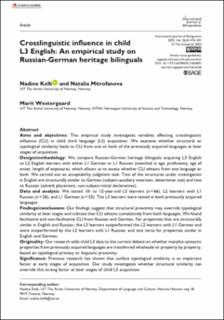| dc.contributor.author | Kolb, Nadine | |
| dc.contributor.author | Mitrofanova, Natalia | |
| dc.contributor.author | Westergaard, Marit | |
| dc.date.accessioned | 2023-01-09T07:33:17Z | |
| dc.date.available | 2023-01-09T07:33:17Z | |
| dc.date.created | 2021-09-14T22:58:03Z | |
| dc.date.issued | 2022 | |
| dc.identifier.issn | 1367-0069 | |
| dc.identifier.uri | https://hdl.handle.net/11250/3041727 | |
| dc.description.abstract | Aims and objectives:
This empirical study investigates variables affecting crosslinguistic influence (CLI) in child third language (L3) acquisition. We examine whether structural or typological similarity leads to CLI from one or both of the previously acquired languages at later stages of acquisition.
Design/methodology:
We compare Russian-German heritage bilinguals acquiring L3 English to L2 English learners with either L1 German or L1 Russian (matched in age, proficiency, age of onset, length of exposure), which allows us to assess whether CLI obtains from one language or both. We carried out an acceptability judgment task: Two of the structures under investigation in English are structurally similar to German (subject-auxiliary inversion, determiner use) and two to Russian (adverb placement, non-subject-initial declaratives).
Data and analysis:
We tested 10- to 12-year-old L3 learners (n = 66), L2 learners with L1 Russian (n = 26), and L1 German (n = 33). The L3 learners were tested in both previously acquired languages.
Findings/conclusions:
Our findings suggest that structural proximity may override typological similarity at later stages and indicate that CLI obtains cumulatively from both languages. We found facilitative and non-facilitative CLI from Russian and German. For properties that are structurally similar in English and Russian, the L3 learners outperformed the L2 learners with L1 German and were outperformed by the L2 learners with L1 Russian, and vice versa for properties similar in English and German.
Originality:
Our research adds child L3 data to the current debate on whether morpho-syntactic properties from previously acquired languages are transferred wholesale or property by property, based on typological primacy or linguistic proximity.
Significance:
Previous research has shown that surface typological similarity is an important factor at early stages of acquisition. Our study investigates whether structural similarity can override this strong factor at later stages of child L3 acquisition. | en_US |
| dc.language.iso | eng | en_US |
| dc.publisher | SAGE | en_US |
| dc.relation.uri | https://journals.sagepub.com/doi/pdf/10.1177/13670069211054891 | |
| dc.rights | Navngivelse 4.0 Internasjonal | * |
| dc.rights.uri | http://creativecommons.org/licenses/by/4.0/deed.no | * |
| dc.title | Cross-linguistic Influence in Child L3 English: An Empirical Study on Russian-German Heritage Bilinguals | en_US |
| dc.title.alternative | Cross-linguistic Influence in Child L3 English: An Empirical Study on Russian-German Heritage Bilinguals | en_US |
| dc.type | Peer reviewed | en_US |
| dc.type | Journal article | en_US |
| dc.description.version | publishedVersion | en_US |
| dc.source.journal | International Journal of Bilingualism | en_US |
| dc.identifier.doi | 10.1177/13670069211054891 | |
| dc.identifier.cristin | 1934353 | |
| dc.relation.project | Norges forskningsråd: 250857 | en_US |
| dc.relation.project | UiT Norges arktiske universitet: 2062165 | en_US |
| cristin.ispublished | true | |
| cristin.fulltext | original | |
| cristin.qualitycode | 2 | |

